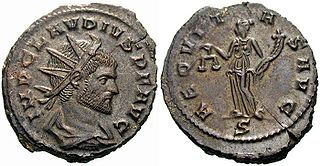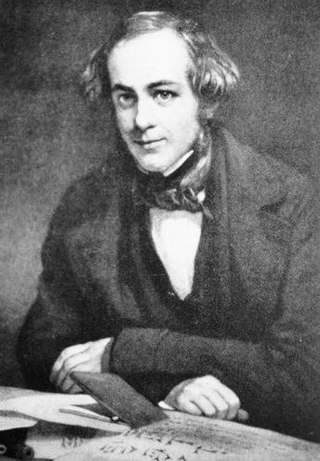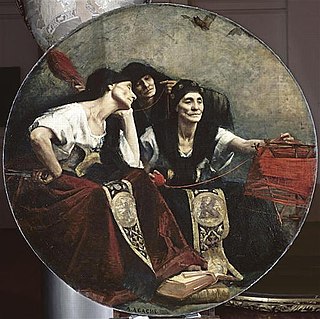Related Research Articles

The denarius was the standard Roman silver coin from its introduction in the Second Punic War c. 211 BC to the reign of Gordian III, when it was gradually replaced by the antoninianus. It continued to be minted in very small quantities, likely for ceremonial purposes, until and through the Tetrarchy (293–313).

Egyptian hieroglyphs were the formal writing system used in Ancient Egypt for writing the Egyptian language. Hieroglyphs combined logographic, syllabic and alphabetic elements, with more than 100 distinct characters. Cursive hieroglyphs were used for religious literature on papyrus and wood. The later hieratic and demotic Egyptian scripts were derived from hieroglyphic writing, as was the Proto-Sinaitic script that later evolved into the Phoenician alphabet. Through the Phoenician alphabet's major child systems, the Egyptian hieroglyphic script is ancestral to the majority of scripts in modern use, most prominently the Latin and Cyrillic scripts and the Arabic script, and possibly the Brahmic family of scripts.

Jean-François Champollion, also known as Champollion le jeune, was a French philologist and orientalist, known primarily as the decipherer of Egyptian hieroglyphs and a founding figure in the field of Egyptology. Partially raised by his brother, the scholar Jacques Joseph Champollion-Figeac, Champollion was a child prodigy in philology, giving his first public paper on the decipherment of Demotic in his mid-teens. As a young man he was renowned in scientific circles, and read Coptic, Ancient Greek, Latin, Hebrew and Arabic.

Egyptology is the scientific study of ancient Egypt. The topics studied include ancient Egyptian history, language, literature, religion, architecture and art from the 5th millennium BC until the end of its native religious practices in the 4th century AD.

Aequitas is the Latin concept of justice, equality, conformity, symmetry, or fairness. It is the origin of the English word "equity". In ancient Rome, it could refer to either the legal concept of equity, or fairness between individuals.

Sir Henry Creswicke Rawlinson, 1st Baronet, KLS was a British East India Company army officer, politician, and Orientalist, sometimes described as the Father of Assyriology. His son, also Henry, was to become a senior commander in the British Army during the First World War.

SextusJulius Saturninus was a Roman usurper against Emperor Probus.

Canopus, also known as Canobus, was an ancient Egyptian coastal town, located in the Nile Delta. Its site is in the eastern outskirts of modern-day Alexandria, around 25 kilometers (16 mi) from the center of that city. Canopus was located on the western bank at the mouth of the westernmost branch of the Delta – known as the Canopic or Heracleotic branch. It belonged to the seventh Egyptian Nome, known as Menelaites, and later as Canopites, after it. It was the principal port in Egypt for Greek trade before the foundation of Alexandria, along with Naucratis and Heracleion. Its ruins lie near the present Egyptian town of Abu Qir.
A parma or parmula was a type of round shield used by the Roman army, especially during the later period of imperial history since the 3rd century.
A catapulta was a Roman machine for throwing arrows and javelins, 12 feet (3.7 m) or 15 feet (4.6 m) long, at the enemy. The name comes from the Greek katapeltes (καταπέλτης), because it could pierce or 'go through' (kata) shields (peltas). The design was probably inherited, along with the ballista, from Greek armies. Some versions of the catapulta were portable. Smaller two-armed versions of the catapulta were known as scorpiones. The catapulta was made of wood and were placed on stands.

In Roman mythology, Morta was the goddess of death. She was believed to preside over infants who died.

The writing systems used in ancient Egypt were deciphered in the early nineteenth century through the work of several European scholars, especially Jean-François Champollion and Thomas Young. Ancient Egyptian forms of writing, which included the hieroglyphic, hieratic and demotic scripts, ceased to be understood in the fourth and fifth centuries AD, as the Coptic alphabet was increasingly used in their place. Later generations' knowledge of the older scripts was based on the work of Greek and Roman authors whose understanding was faulty. It was thus widely believed that Egyptian scripts were exclusively ideographic, representing ideas rather than sounds, and even that hieroglyphs were an esoteric, mystical script rather than a means of recording a spoken language. Some attempts at decipherment by Islamic and European scholars in the Middle Ages and early modern times acknowledged the script might have a phonetic component, but perception of hieroglyphs as purely ideographic hampered efforts to understand them as late as the eighteenth century.

The Montefortino helmet was a type of Celtic, and later Roman, military helmet used from around 300 BC through the 1st century AD with continuing modifications. This helmet type is named after the region of Montefortino in Italy, where a Montefortino helmet was first uncovered in a Celtic burial. The Montefortino helmet originated in the 4th century BCE and was influenced by Etruscan and Celtic helmets. The helmet was brought to Italy by the Senones and it was the most popular helmet amongst the Roman army during the Republican period. The Montefortino helmet remained the most popular Roman helmet until the first century CE. Although in the Roman military it was replaced by the Coolus helmet, it continued to be used by the Praetorian guard.

The Coolus helmet was a type of ancient Celtic and Roman helmet popular in the 1st century BCE. It was typically made in bronze or brass and, like the Montefortino type with which it co-existed, was a descendant of Celtic helmet types. The explanation of the choice to use bronze can be attributed to the type of warfare that the helmet was used for; also the cultural affinities have influence on why the helmet was made the way that it was. Within a long process of evolution, Roman military armor for the head developed from early pre-Roman helmets. Rome itself had no proper tradition of such objects, as most of the soldiers of the Early Republic made use of helmets produced by the Etruscans, whose craftsmen were known for their ability to make vessels.
In ancient Roman religion, Fornax was the divine personification of the oven (fornāx), the patroness of bakers, and a goddess of baking. She ensured that the heat of ovens did not get hot enough to burn the corn or bread. People would pray to Fornax for help whilst baking. Her festival, the Fornacalia, was celebrated on February 17 among the thirty curiae, the most ancient divisions of the city made by Romulus from the original three tribes of Rome. The Fornacalia was the second of two festivals involving the curiae, the other being the Fordicidia on April 19. The goddess was probably conceived of to explain the festival, which was instituted for toasting the spelt used to bake sacrificial cakes. Her role was eventually merged with the goddess Vesta.

Decima was one of the three Parcae in Roman mythology. The Parcae goddess Nona was responsible for pregnancy; Decima was responsible for birth; and Morta was charged with overseeing death. They distributed to mankind all the good and bad things in life, and according to some classical writings even Jupiter had to bend to their will. Decima measured the thread of life with her rod, like her Greek equivalent Lachesis. In some accounts, her mother was Nox the goddess of night and her father was Erebus the god of darkness; while in other accounts, her parents were Jupiter and Themis.
Richard H. Wilkinson is an archaeologist in the field of Egyptology. He is Regents Professor Emeritus, Ph.D. at the University of Arizona and founding director of the University of Arizona Egyptian Expedition. He conducted research and excavation in Egypt for 25 years, mainly in the Valley of the Kings, and most recently excavating the royal temple of Twosret, a queen of the Nineteenth Dynasty of Egypt who ruled Egypt as a king.
Christina Riggs is a British-American historian, academic, and former museum curator. She specializes in the history of archaeology, history of photography, and ancient Egyptian art, and her recent work has concentrated on the history, politics, and contemporary legacy of the 1922 discovery of Tutankahmun's tomb. Since 2019, she has been Professor of the History of Visual Culture at Durham University. She is also a former Fellow of All Souls College, Oxford. The author of several academic books, Riggs also writes on ancient Egyptian themes for a wider audience. Her most recent books include Ancient Egyptian Magic: A Hands-On Guide and Treasured: How Tutankhamun Shaped a Century.
Valerie Maxfield FSA is a Roman archaeologist and emeritus Professor of Archaeology at the University of Exeter. She is a specialist in the archaeology of the Roman army and frontiers, and edited the Proceedings of the Devon Archaeological Society until December 2020.

The Roman pharaohs, rarely referred to as ancient Egypt's Thirty-fourth Dynasty, were the Roman emperors in their capacity as rulers of Egypt, especially in Egyptology. After Egypt was incorporated into the Roman Empire in 30 BC, the people and especially the priesthood of the country continued to recognize the Roman emperors as pharaohs, according them traditional pharaonic titularies and depicting them with traditional pharaonic garb, engaging in traditional pharaonic activities, in artwork and at temples throughout Egypt.
References
- ↑ "Lesley Adkins".
- ↑ "Authors Roy and Lesley Atkins give a talk at Appledore Book Festival". North Devon Journal. 3 October 2013. Retrieved 10 November 2016.
- ↑ "The Keys of Egypt by Lesley and Roy Adkins". The Complete Review. Retrieved 10 November 2016.
- ↑ "Empires of the Plain Henry Rawlinson and the Lost Languages of Babylon". Conville & Walsh. Retrieved 10 November 2016.
- ↑ "Roy and Lesley Adkins's top 10 Nelson books". The Guardian. 29 September 2008. Retrieved 10 November 2016.
- ↑ "Adkins, Roy 1951– | Encyclopedia.com".
- 1 2 3 "Roy Adkins & Lesley Adkins". Historic Naval Fiction. Archived from the original on 23 October 2016. Retrieved 10 November 2016.
- ↑ "Adkins, Lesley 1955– | Encyclopedia.com".
- ↑ "Tar for the memories". Navy News : 45. November 2008.